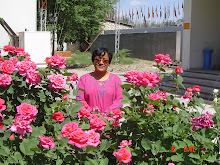Smiles on their Faces: School Feeding Programmes in Afghanistan
by Devaki Shrestha
09 June 2008Faizabad, Afghanistan: When I found out about the UNV programme, I was most impressed with the idea that by being a volunteer, I could contribute and learn simultaneously. In 1998, I was selected as a UNV specialist by the Afghanistan programme. Notwithstanding a few periodic intervals, I stayed there until December 2007. Out of my UNV assignments covering six and a half years, I worked with the World Food Programme (WFP) for about four years. As a UNV volunteer, the most valuable achievement for me was simply the great sense of satisfaction. I think I contributed whatever I was capable of with the profound desire to help people in great need of support. In retrospect, despite people's struggles to survive, the happiness seen on their faces were rays of light; and their 'never-say-die' attitude still makes me dream of Afghanistan.I remember a mission to Faizabad in the north-eastern part of Afghanistan with my team in the spring of 2006. The province is famous for its panoramic views and the virgin beauty of its landscape. After a half-hour drive on the rough road from the airport, we reached the WFP Faizabad Area Office. The Area Office was supporting food insecure areas, targeting vulnerable people from the most remote districts. Due to the rugged mountainous terrain, logistics management was a nightmare, especially during the snowy winter and rainy season. The width of the trails was just enough for one vehicle at a time to pass. Food supplies for the winter usually started from the month of June. If they were delayed, they faced lots of challenges due to vehicles being blocked by landslides, vehicles stuck on muddy roads etc. On 25 May we proceeded to Sohada District. Our objective was to observe the impact of the WFP school feeding programme. Arable land was limited there, and the people were extremely poor. Most depended on subsistence farming and labour work.We saw many schools. We talked with teachers, students, parents and communities. It was really a pity to see the learning conditions. Most schools did not have buildings at all. Even furniture was a luxury for these innocent children. Those schools which had buildings offered benches and desks, but these were not available to most children in the area. Many had to sit inside tents provided by UNICEF during the Back to School Campaign, probably in 2002. The children in the tents used to sit on plastic sheets, if they had not carried sacks from their homes. Instead of backpacks for their books, the children used to come with plastic bags and a few even carried bags made from empty fruit juice cartons. When numbers of children carried such cartons, it was very colourful.The WFP Faizabad Area Office had been supporting the school feeding programme for about 131,700 school attending children, out of which over 60,000 were girls. They received wheat as a take-home monthly ration. This had the objective of encouraging them to attend school. To bridge the gender gap the girls received oil incentives too, so that parents were encouraged to send their daughters to school.As most of the schools did not have a building, managing data or keeping records of the children’s enrolment, attendance and success rates were nearly nonexistent. When asked, the teachers and headmasters simply estimated from their heads. The lack of female teachers in the remote areas meant girls dropped out of school after class 5 as parents did permit them to attend classes taught by male teachers. We visited one pilot school in Sohada built with WFP support. This building, at least, gave us hope that things could become better by partnering with communities. The District Governor was active in bringing communities together. The plot of land was donated by one of the religious mullahs, who was also a teacher at the school. The communities around that school were more open to send their girls there, and community members had also participated in GAIN (Green Afghanistan Initiative) activities by planting trees around the school compound. At least, the children were lucky enough to attend the class inside rooms. They had the pleasure of sitting on benches and putting their books on desks. It was revealed during my tour of the area that WFP support had been a positive factor for increased enrolment and attendance rate for both boys and girls. People had become aware of the importance of education. The additional food support had encouraged needy parents to send their children to the school rather than sending them to work. Most had started to send their children even at the younger ages of five or six, which was not common practice before. Another visible change was that communities accepted mixed classes of boys and girls up to class three, which was not possible during the time of the Taliban regime. Most community members and teachers said that the food aid should be continued at least for another couple of years until the enrolled students completed their primary level, to reduce the chance of dropping out. Although the children had to attend classes in tents, they were happy to come to school. There were smiles on their faces. Perhaps this was the most telling impact of the programme.
Devaki Shrestha is a Nepali national qualified in social development. She graduated with social development diploma qualification from Coady International Institute, Canada, in 1988.
www.unv.org/en/perspectives/doc/smiles-on-their-faces.html June 2008.
Subscribe to:
Post Comments (Atom)

No comments:
Post a Comment